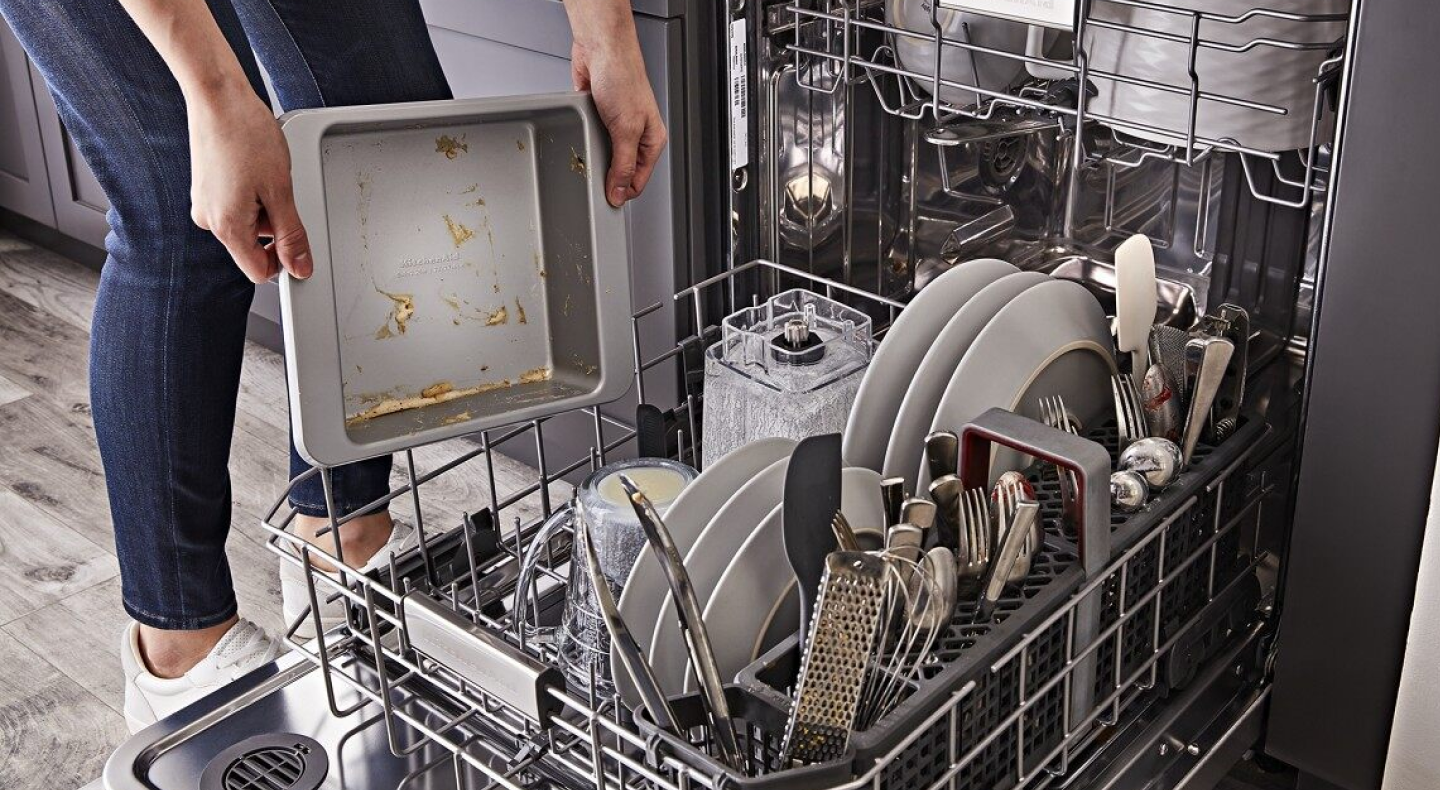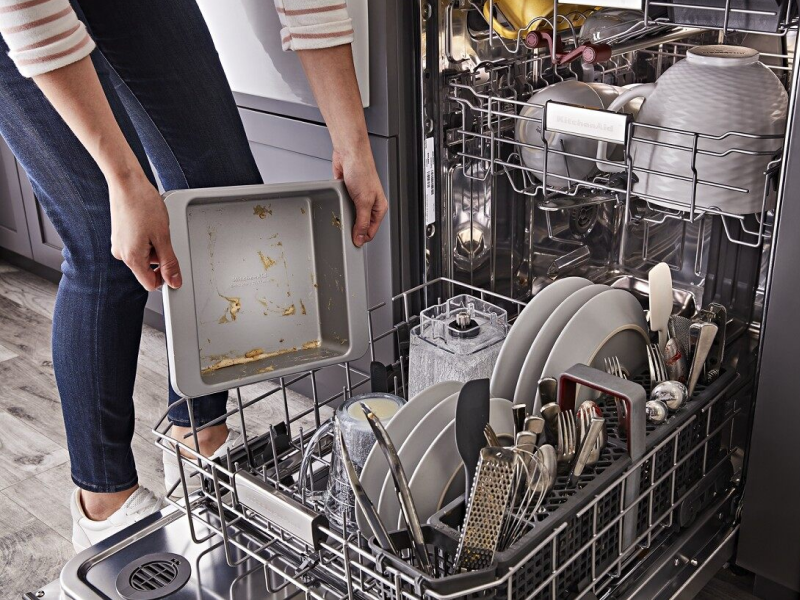
How to unclog a dishwasher & help prevent future clogs
Your dishwasher helps with clean-up after you’ve experimented with a twist to your favorite recipe. But a clogged dishwasher can interrupt the flow of creativity in the kitchen.
If you suspect that your dishwasher is clogged, there are a few key signs to look out for. A dishwasher that is not draining properly or has standing water in the bottom of the tub, is probably clogged. This can lead to unpleasant odors and ineffective cleaning of your dishes. Instead of waiting for a technician to fix the issue, there are steps you can take to attempt to unclog it, so you can get back to making. Read on to learn how you can potentially solve this problem on your own.
What are the signs that a dishwasher problem is due to a clog?
There are a few tell-tale signs that may indicate that your dishwasher water is not draining properly. Your dishwasher may be making a gurgling sound, draining slowly or not at all, or your dishes aren’t properly cleaned. You may also notice an unpleasant odor, water backing up in the kitchen sink or leftover water in the dishwasher tub after a wash cycle.
Why is my dishwasher clogged?
If you have a clogged dishwasher drain, several factors may be causing the issue. Among the potential culprits is a clogged filter. Another possible hindrance could stem from blockages within the dishwasher’s drain hose or valve, an air gap or even issues with your garbage disposal.


How to troubleshoot a clogged dishwasher
Read the steps below to learn how to potentially unclog your dishwasher and get back to a hassle-free dishwashing experience.
Tools
Towels
Cup, turkey baster or sponges
Soft brush, such as an old toothbrush
Step 1: Empty the dishwasher
Start by emptying the dishwasher so you can have a clear view of the inside as you look for the problem.
Step 2: Disconnect it from power
Disconnect the dishwasher from its power source before you begin the troubleshooting process. If you have a built-in dishwasher, you can turn off the breaker switch that it’s connected to.
Step 3: Empty standing water
If there’s any standing water in the dishwasher, remove it to help make the drain accessible while you troubleshoot. You can scoop the water out with a cup and then dry it with towels or try using a wet/dry vacuum, a turkey baster or a sponge.
Step 4: Examine the air gap cylinder and garbage disposal
If you find that the garbage disposal isn't causing the problem, take a close look at the air gap cylinder. It plays a crucial role in ensuring proper water flow during the wash cycle and preventing water from backing up into the dishwasher's tub. To find the cylinder, first check behind the sink near the dishwasher hose. Make sure to thoroughly clean any build-up in the air gap cylinder and securely reconnect it in its designated position. It's important to ensure a tight seal for best functioning results.
Step 5: Inspect the drain motor, valve and hose
If you're still finding that your appliance is not draining properly, there could be additional reasons for the clogged dishwasher drain. A malfunctioning drain motor or a blocked drain hose can also result in standing water at the bottom of the dishwasher. A jammed drain valve bracket could indicate burnt-out electrical components. Contact a service technician to address these issues and perform a thorough inspection.
Step 6: Schedule professional service
If your dishwasher is clogged and you can’t seem to solve the problem yourself or you’re dealing with an issue like a defective drain motor or clogged drain hose, you may need to call a professional.
Your KitchenAid® dishwasher owner’s manual should be able to help you keep your appliance functioning, but if the need arises, you can conveniently schedule service online with an authorized service technician.

Find the right dishwasher for you
Can a clogged dishwasher filter cause a leak?
While a small amount of standing water in the dishwasher filter area is normal, excessive water accumulation—typically more than an inch—could indicate a clog. This can impede proper drainage, causing water levels to rise and potentially result in a dishwasher leak.
How do I prevent my dishwasher from clogging?
To avoid a clogged dishwasher, it is crucial to clean and maintain your dishwasher regularly. This involves various tasks, such as but not limited to:
- Selecting a hot water cycle
- Consistently inspecting and thoroughly maintaining the dishwasher filter on a regular basis
- Running the dishwasher frequently and only using dishwasher detergent
- Cleaning leftover food and debris from dishes before loading the dishwasher
- Cleaning the inside, the outside and any other parts of the dishwasher you can reach
Learn more about troubleshooting a dishwasher.
360° MAX JETS™ THIRD RACK
Fall in love at first wash
With this KitchenAid® dishwasher, you can load big messes without pre-rinsing thanks to 50 targeted wash jets plus 360° wash action on the third rack
Shop KitchenAid® dishwashers
If it’s time for a dishwasher upgrade, explore options from KitchenAid brand. Select models include features like the Advanced Clean Water Wash System that continuously filters and circulates clean water, and the ProWash™ Cycle that uses sensors to measure soil levels throughout the cycle and adapts the wash time and water temperature. KitchenAid brand has the type of dishwasher you need to keep messes minimal so you can focus on creativity.

KitchenAid® Hardware Accessory Kits
Curate the colors and textures that move you
From bold Black Ore to the inviting warmth of Bronze, mix and match handles and knobs to refresh your appliances and bring new energy to your kitchen
